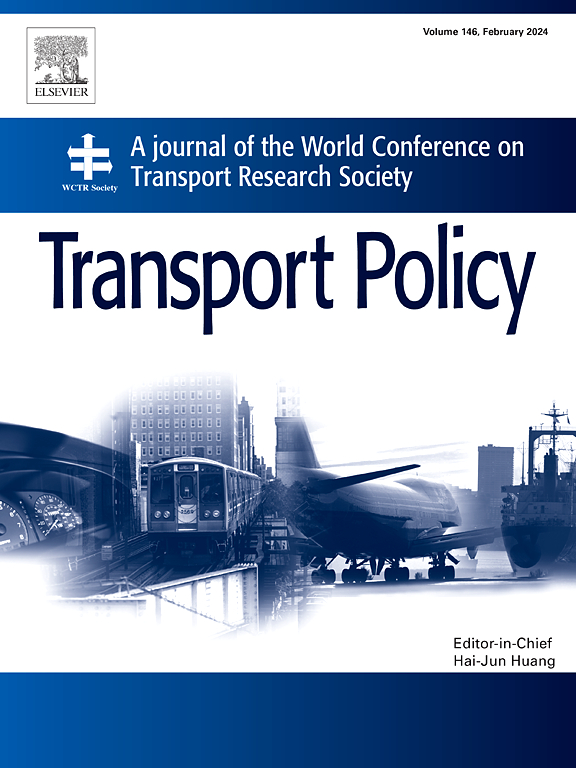Understanding public perceptions of autonomous vehicles: A structural model to urban-rural differences and psychological factors
IF 6.3
2区 工程技术
Q1 ECONOMICS
引用次数: 0
Abstract
Autonomous vehicles (AVs) promise the potential to revolutionize road transport by mitigating traffic congestion and greenhouse gas emissions while enhancing accessibility and road safety. However, the adoption and deployment of AVs hinge on public perceptions of this new technology. This study aimed to investigate the disparities between urban and rural areas in China concerning public attitudes towards AVs and the willingness to use them. By collecting 1764 questionnaires, we found that respondents from urban and rural areas showed substantial differences in their attitudes towards and willingness to use AVs. Specifically, urban respondents were more willing to use AVs and held more positive attitudes than their rural counterparts. Additionally, sociodemographic factors such as income and education, road conditions such as the clarity of traffic signs and traffic congestion, as well as perceived benefits, safety, and trust towards AVs, were significantly associated with the willingness to use AVs. Although the presence of bike lanes and road spaciousness were not directly associated with the willingness to use AVs, our results revealed that these factors mediated the relationship between residence and the willingness to use AVs. Our findings highlight the importance of bridging the urban-rural divide in education, income, and road infrastructure during the development and deployment of AVs. Furthermore, given the significantly different attitudes toward AVs between urban and rural areas, policymakers should adopt distinct policy approaches for urban and rural areas when AVs enter the mass market in developing countries in the future.
理解公众对自动驾驶汽车的看法:城乡差异和心理因素的结构模型
自动驾驶汽车(AVs)有望通过缓解交通拥堵和温室气体排放,同时提高可达性和道路安全性,彻底改变道路运输。然而,自动驾驶汽车的采用和部署取决于公众对这项新技术的看法。本研究旨在调查中国城乡公众对自动驾驶汽车的态度和使用意愿的差异。通过收集1764份问卷,我们发现城市和农村受访者对自动驾驶汽车的态度和使用意愿存在显著差异。具体而言,城市受访者比农村受访者更愿意使用自动驾驶汽车,并持有更积极的态度。此外,社会人口因素(如收入和教育程度)、道路状况(如交通标志的清晰度和交通拥堵)以及对自动驾驶汽车的感知利益、安全性和信任度都与使用自动驾驶汽车的意愿显著相关。虽然自行车道的存在和道路的宽阔程度与自动驾驶汽车的使用意愿没有直接关系,但我们的研究结果表明,这些因素介导了居住与自动驾驶汽车使用意愿之间的关系。我们的研究结果强调了在自动驾驶汽车的开发和部署过程中,弥合教育、收入和道路基础设施方面的城乡差距的重要性。此外,鉴于城市和农村对自动驾驶汽车的态度存在显著差异,未来在发展中国家,当自动驾驶汽车进入大众市场时,政策制定者应该采取不同的城市和农村政策手段。
本文章由计算机程序翻译,如有差异,请以英文原文为准。
求助全文
约1分钟内获得全文
求助全文
来源期刊

Transport Policy
Multiple-
CiteScore
12.10
自引率
10.30%
发文量
282
期刊介绍:
Transport Policy is an international journal aimed at bridging the gap between theory and practice in transport. Its subject areas reflect the concerns of policymakers in government, industry, voluntary organisations and the public at large, providing independent, original and rigorous analysis to understand how policy decisions have been taken, monitor their effects, and suggest how they may be improved. The journal treats the transport sector comprehensively, and in the context of other sectors including energy, housing, industry and planning. All modes are covered: land, sea and air; road and rail; public and private; motorised and non-motorised; passenger and freight.
 求助内容:
求助内容: 应助结果提醒方式:
应助结果提醒方式:


